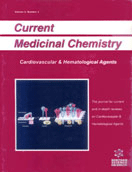Abstract
The thrombin receptor on human platelets is the first member identified of a new family of G-protein coupled receptors referred to as protease activated receptors (PARs). These receptors are activated by a unique mechanism involving proteolytic cleavage of a portion of the extracellular domain to generate a new N-terminus which then acts as a tethered or intramolecular ligand (agonist) for the receptor. The hexapeptide SFLLRN-NH2 comprising the new Nterminus is referred to as the Thrombin Receptor Activating Peptide, or “TRAP”. Thrombin is the most potent agonist for platelet aggregation and selective blockade of the intramolecular activation step without effecting the proteolytic activity of thrombin should result in moderation of platelet activation and aggregation without interfering with the other coagulation cascade effects of thrombin. Screening of combinatorial libraries identified a novel, non-peptide PAR-1 thrombin receptor antagonist. Examination of structure-activity relationships revealed that portions of the molecule could be replaced resulting in simpler molecules of lower molecular weight that were at the same time more potent. Molecules in this series were effective antagonists of TRAP-stimulated platelet activation, but had limited activity when thrombin was the agonist. Additional directed screening and subsequent lead refinement resulted in a second series of isoxazole based compounds. Some of the resultant molecules were potent PAR-1 antagonists that were effective against both TRAP- and thrombin-stimulated receptor activation. These compounds do not inhibit the proteolytic effects of thrombin but rather interfere with the intramolecular binding of the tethered ligand (SFLLRN) to the transmembrane portion of the thrombin receptor. They represent promising leads for future explorations of antithrombotic activity of thrombin receptor antagonists.
Keywords: platelet, thrombin receptor antagonist, protease activated receptor, thrombosis
 11
11













